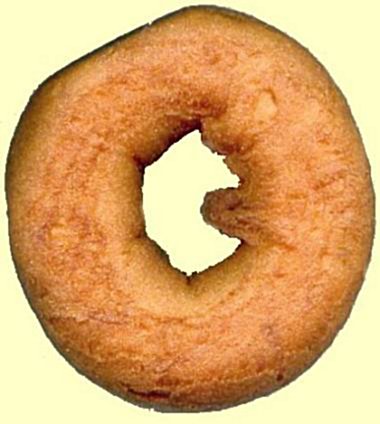A Priority Allegory
Today, doughnuts and priority. The University of Houston's College of Engineering presents this series about the machines that make our civilization run, and the people whose ingenuity created them.
The question I'm most often asked is, "Who first invented this or that machine?" The problem is that no one was first to invent anything, ever. Invention always builds upon antecedents. That's why patent law deals with ownership more than invention.
That said, let's ask who invented the doughnut. I've just discovered a short article that attributes it to Maine sea captain Hanson Gregory. Gregory's ship was named Frypan, and he fed his sailors "fried cakes," made according to his mother's recipe.
A problem with those otherwise delicious cakes was that their centers were seldom fully cooked. In 1847, Gregory punched out the center of a cake. Now all the dough lay near the cooked surface, and he got a far more uniformly cooked doughnut. That story is often told with embroidery about eating doughnuts during storms at sea, about punching the hole with a belaying pin, and so on.
Massachusetts rose to Maine's challenge. They claimed to've produced the first doughnut much earlier. Some Indians found a Cape Cod Pilgrim woman deep-frying cakes in an outdoor pot. They decided to frighten her off by firing an arrow so it would noisily strike the pot. Then they could steal the cakes. But the shooter's aim was high. Just as the woman reached over to put another cake in the pot, the arrow drilled a hole through it. The woman screamed and fled. When she did, she dropped the cake into the oil, and the first doughnut was cooked. But that was in Massachusetts. According to Vermonters, their native son Shadrach Gowallapus Hooper invented the doughnut.
If one expects a patent to resolve the question, one gets John Blondell's 1872 patent for a wooden doughnut-cutter -- very late in the game. A tin cutter was patented seventeen years later.
Naturally, when one looks closely, one finds European antecedents. And, from time immemorial, India has prepared a deep-fried doughnut whose dough is made from lentils. It's called a vada. Another solution to the problem of cooking a cake uniformly is far cleverer than the doughnut, and very old. The New Orleans beignet and India's poori are only two examples of cakes hollowed out from the inside rather than drilled through. In both cases, steam pressure created within the dough inflates it like a balloon.
All this grows more pointed as the Wright Brothers' Centennial puts priority back under a spotlight. New Zealand is making an energetic counterclaim. So too are Connecticut, Great Britain, California -- even Texas. I remain content to say that the Wright Brothers were first to fly -- as long as we saddle their claim with enough adjectives. They made the first, powered, heavier-than-air, controlled, repeatable, flight.
But naming the first mousetrap, automobile, electric light, or airplane ... It all makes about as much sense as trying to name the first doughnut hole.
I'm John Lienhard, at the University of Houston, where we're interested in the way inventive minds work.
(Theme music)
The Inventive Yankee: From rockets to roller skates, 200 years of Yankee inventors & inventions. (Andrea Chesman, ed.) Doublin, NH: Yankee Books, 1989, pp. 84-85.
